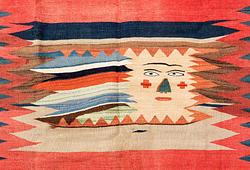Carl Milles
"Bror och syster" (=Brother and sister)
Stamp signed C Milles. Foundry mark LR20 Cire perdue. Height 60 cm (including stone base 65 cm).
Literature
Henrik Cornell, Carl Milles - hans verk", SAK, 1963, mentioned an compare ill. at p. 144.
More information
In the Falls Church cemetery outside Washington, Carl Milles was commissioned in 1940 to make a large fountain with several different sculptures in the form of human figures in different groupings. It was named The Fountain of Faith and became Carl Milles’ most extensive work of art and what he himself came to regard as his foremost. Each of the fountain's life-size figures evokes a specific individual whom Milles knew before their death.
The current catalogue number called "Brother and sister" is one of the sculpture groups originally made for this fountain but Milles later decided not to use. Instead, he made this slender group a stand-alone composition.
Artist
Carl Milles was a Swedish sculptor born in Lägga. He studied at the Technical School in Stockholm, at the Ecole des Beaux-Arts in Paris under Auguste Rodin and on study trips to Germany, the Netherlands and Belgium. In Paris he came to stay for many years and made a living as an ornament carver. He studied the animals in the Jardin des Plantes (the Zoological Garden) and was strongly influenced by Auguste Rodin. Milles made a breakthrough with a monument to Sten Sture in Uppsala. He exhibited at the World's Fair in 1900 and was later given a solo exhibition at the Tate Gallery in London. Milles was professor of modeling at the Royal Academy of Arts in Stockholm. Well-known sculptures in public places signed by Carl Milles are the "Gustav Vasa" statue at the Nordic Museum, "Orfeusgruppen" outside the concert hall in Stockholm and the "Poseidonfontänen" in Gothenburg.
Read more

















































